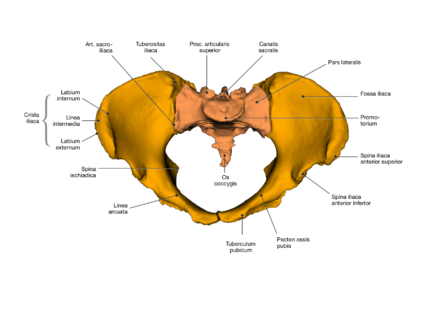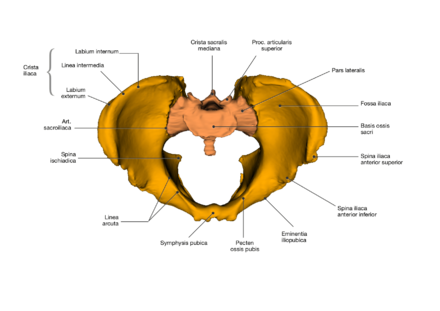Knöchernes Becken/en: Unterschied zwischen den Versionen
Becher (Diskussion | Beiträge) (Die Seite wurde neu angelegt: „==Gender-specific differences==“) |
Becher (Diskussion | Beiträge) |
||
| (5 dazwischenliegende Versionen desselben Benutzers werden nicht angezeigt) | |||
| Zeile 4: | Zeile 4: | ||
The pelvis is between the abdomen and the legs (<i>membrum inferius</i>). | The pelvis is between the abdomen and the legs (<i>membrum inferius</i>). | ||
| − | The pelvic girdle consists of the two hip bones (<i>Ossa coxae</i>) and the [[Kreuz- und Steißbein | + | The pelvic girdle consists of the two hip bones (<i>Ossa coxae</i>) and the [[Special:MyLanguage/Kreuz- und Steißbein|sacrum and coccyx]] (<i>Os sacrum</i> and <i> Os coccygis</i>). |
| − | |sacrum and coccyx]](<i>Os sacrum</i> and <i> Os coccygis</i>). | ||
It also consists of the ilium blade, the acetabulum, the pubis and ischium and the symphysis. The connection of sacroiliac joints, pubic symphysis (<i>symphysis pubica</i>) and sacrum forms the stable pelvic ring. | It also consists of the ilium blade, the acetabulum, the pubis and ischium and the symphysis. The connection of sacroiliac joints, pubic symphysis (<i>symphysis pubica</i>) and sacrum forms the stable pelvic ring. | ||
<br> | <br> | ||
| Zeile 49: | Zeile 48: | ||
==Gender-specific differences== | ==Gender-specific differences== | ||
| − | |||
<div style="float:right;margin:1em;"> | <div style="float:right;margin:1em;"> | ||
<segmenter border="1" height="400px">https://dornheim.cloud/index.php/apps/segmenter/embedding/view?identifier=Hhl78b5rVChQ</segmenter> | <segmenter border="1" height="400px">https://dornheim.cloud/index.php/apps/segmenter/embedding/view?identifier=Hhl78b5rVChQ</segmenter> | ||
</div> | </div> | ||
| − | + | The bony pelvis forms the static basis of the pelvis. It consists of a small and a large pelvis. The small pelvis forms the birth canal in women. The woman's pelvis develops further and more outwardly than that of the man. The male pelvis, on the other hand, is steeper, stronger and narrower. The <i>Promontorium</i> is also more pronounced. The biggest difference is the ''pubic angle''. In women it is on average between 90 - 100° and in men always below 90° (approx. 70°). In men it is called <i>Angulus subpubicus</i>, in women it is called <i>Arcus pubis</i>. | |
| − | + | Differences can also be found in the sacrum, for example in men it is evenly curved and in women from the 3rd and 4th vertebrae it is bent. | |
| − | '' | + | ''Look at the differences in the <!--[segmenter_snapshot becken 0]-->"Webviewer"<!--[/]-->.'' |
| Zeile 63: | Zeile 61: | ||
---- | ---- | ||
| − | '' | + | ''Further links'' |
| − | '''[[Special:MyLanguage/Übungsaufgaben| | + | '''[[Special:MyLanguage/Übungsaufgaben|Exercises]]''' |
| − | [[Special:MyLanguage/Rumpfwand| | + | [[Special:MyLanguage/Rumpfwand|back to the trunk wall]] |
Aktuelle Version vom 3. Januar 2020, 08:42 Uhr
Inhaltsverzeichnis
General information
The pelvis is between the abdomen and the legs (membrum inferius).
The pelvic girdle consists of the two hip bones (Ossa coxae) and the sacrum and coccyx (Os sacrum and Os coccygis).
It also consists of the ilium blade, the acetabulum, the pubis and ischium and the symphysis. The connection of sacroiliac joints, pubic symphysis (symphysis pubica) and sacrum forms the stable pelvic ring.
Ventral view
Dorsal view
Cranial view
Gender-specific differences
<segmenter border="1" height="400px">https://dornheim.cloud/index.php/apps/segmenter/embedding/view?identifier=Hhl78b5rVChQ</segmenter>
The bony pelvis forms the static basis of the pelvis. It consists of a small and a large pelvis. The small pelvis forms the birth canal in women. The woman's pelvis develops further and more outwardly than that of the man. The male pelvis, on the other hand, is steeper, stronger and narrower. The Promontorium is also more pronounced. The biggest difference is the pubic angle. In women it is on average between 90 - 100° and in men always below 90° (approx. 70°). In men it is called Angulus subpubicus, in women it is called Arcus pubis. Differences can also be found in the sacrum, for example in men it is evenly curved and in women from the 3rd and 4th vertebrae it is bent.
Look at the differences in the "Webviewer".
Further links





